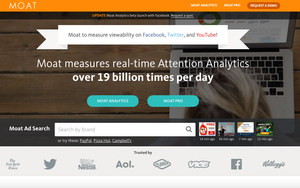Will Moat's New Digital Ad Metric Rival The Measurement Giants?
- by Felicia Greiff , March 22, 2016
 Web analytics firm Moat raised $50 million to develop a new metric to rival the likes of Google, Nielsen and comScore.
Web analytics firm Moat raised $50 million to develop a new metric to rival the likes of Google, Nielsen and comScore. In an investment round led by Insight Venture Partners (which has invested in companies including Twitter, Chegg, Tumblr, Flipboard and Hootsuite), Moat will create a "new ad currency" aimed at helping advertisers and publishers assess whether people pay attention to digital ads and are influenced by them, The Wall Street Journal reported.
Currently, the Journal reported, the metric is in development. And for the record, chief executive Jonah Goodhart said Moat sees companies like Nielsen and Google as potential partners in its new metric project.
Will a new currency catch on?
Tom Burg, VP-product marketing, Centro (a Moat partner), said in an email that brands lament the fact that buying and measuring digital is so complicated relative to TV, and "anything that can be done to narrow the gap between the two experiences is going to be a positive for all of us."
Kimber Robbins, VP-product management of the IPG Mediabrands ad tech unit Cadreon (which works with Moat on some campaigns), said in an email that there's room to improve current standards, adding that Cadreon would prefer independent measurement specialists provide the currency rather than major inventory owners who may introduce bias to their own inventory. She added that the company wants to move away from using proxies rather than a direct measurement of the thing it's really interested in:rather than viewability, the impact of an ad’s contribution to the campaign goal.
Moat shouldn’t underestimate the task of introducing a new metric, Robbins said, mentioning last-touchpoint attribution as an example of an industry standard that's been resistant to change. Most clients are still working on that model since it’s what they know, she said, and Moat will probably find similar intransigence.
Jon Bond, founder of marketing services holding company Tomorro, said over email that measurement currencies have always been blunt instruments, and a new one would have to be flexible and multidimensional to work with the hyper-relevance of digital.
"I think it would have to be more about currencies than currency to move this forward," Bond said.


